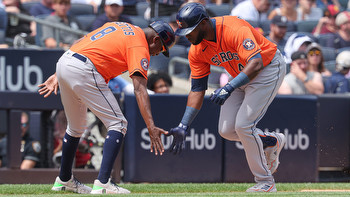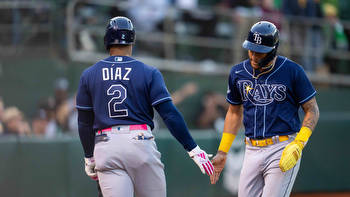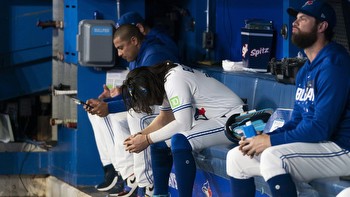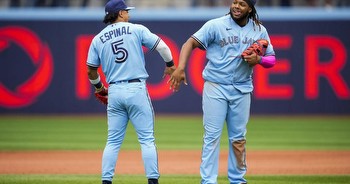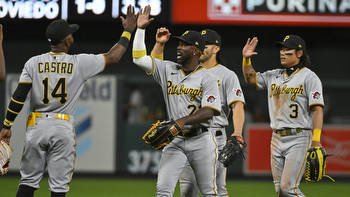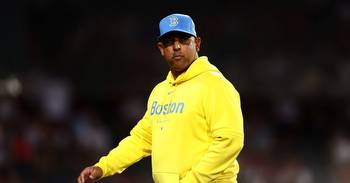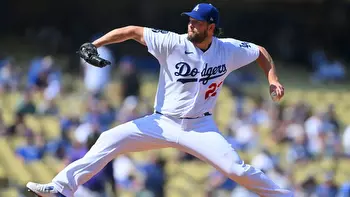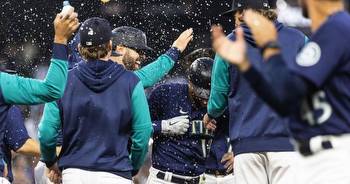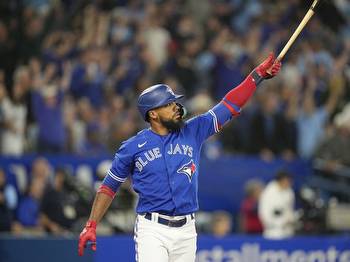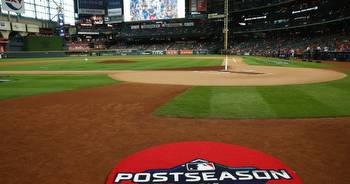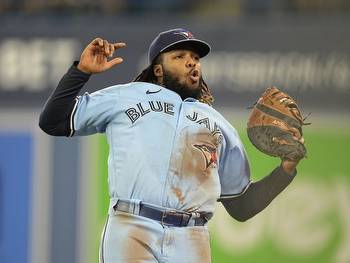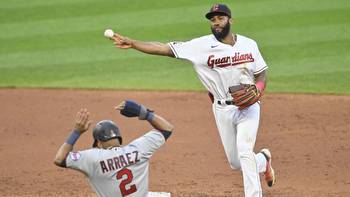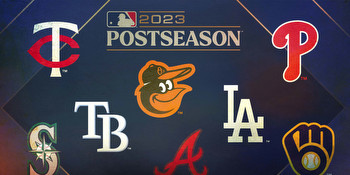MLB Notebook: Crunching the numbers on Red Sox’s longshot playoff chances

There’s an avalanche of numbers available to the average fan on any number of public websites and organizations also have their own proprietary data.
Want to quantify anything about the game? The truth is out there — somewhere.
But while there’s a smorgasbord of numbers for every facet of the game, at the end of the day, the most important one relates to how many wins you have.
After losing the Washington Nationals Thursday to drop the first series of a 10-game road trip, the Red Sox have 63 wins in 121 games, with 41 — one-quarter of the schedule — remaining.
Visit BetMGM.com for Terms and Conditions. 21 years of age or older to wager. MA Only. New Customer Offer. All promotions are subject to qualification and eligibility requirements. Rewards issued as non-withdrawable bonus bets. Bonus bets expire 7 days from issuance. In Partnership with MGM Springfield. Play it smart from the start with GameSense. GameSenseMA.com. Gambling Problem? Call 1-800-327-5050 or visit gamblinghelplinema.org.Following Thursday’s action, the Red Sox’s odds of qualifying for the playoffs were just 6.9 percent. Meanwhile, the Toronto Blue Jays, who sat three and a half games ahead of them in the standings — and just three games ahead in the loss column — had far better odds at 69.2 percent.
(That huge disparity in odds, despite the relatively similar records, is a reflection of several things, including remaining schedule and run differential. In the latter, the Jays were a +55, almost exactly twice as good as the Red Sox at +28.)
It’s interesting to note, too, how much the Red Sox fallen in terms of their mathematical odds, in the last 30 days. The Sox have dipped 24.7 percent, a reminder of how much their poor West Coast road trip (2-4) and the subsequent sweep at home by Toronto hurt their chances.
But enough with the percentages. Let’s get down to the actual hard numbers: How many games will the Red Sox need to win to grab one of the American League wild card spots for the postseason? There’s no precise answer to that question, of course, but there are some hints that can help reach an educated guess.
- Mobile sports betting is live in Massachusetts on BetMGM. Get started with a $1,000 first-bet offer
Last year represented the first season in which Major League Baseball went to the three wildcard setup. (From 2012 to 2021, there were two wild card entrant per league). Last fall, the three wild card teams in the American League were the Toronto Blue Jays (92 wins), Seattle Mariners (90 wins) and the Tampa Bay Rays (86 wins).
So, if the Red Sox were to go just 23-18 in their final 41 games, that would leave them with 86 wins, the same number the Rays had while qualifying for the third spot last October while finishing third in the AL East, and that would be enough, correct?
Not necessarily. Thanks to a significant change in the schedule format, comparing the 2023 race to the one in 2022 is highly problematic. Last year, while playing each division rival 19 times each, teams played 76 games within their own division, 66 games against all other teams in their own league and 20 interleague games.
This year, the format is completely altered. Teams now play just 52 games in their own division (13 games each per division opponent), 46 interleague and 64 against teams from the rest of their own league. So the dynamic changes, and particularly in a quality division like the AL East, with four teams owning winning records and the fifth just a game below .500, the win totals are likely to be higher than a year ago.
For argument’s sake, let’s say the number increases to 88 games.
- Massachusetts online sports betting is live. Learn more about the top sportsbook operators in Mass. such as FanDuel, DraftKings and BetMGM to find the best offers available.
That would mean the Red Sox would need to go 25-16 over their last 41, a winning percentage of .610. For the season to date, the Red Sox have a winning percentage of .521, so that kind of jump would hardly be unprecedented over the final six weeks. That’s especially true now that the Red Sox have Trevor Story, Chris Sale, Garrett Whitlock and, soon, Tanner Houck healthy.
But, of course, these things can’t be measured in a vacuum. The Red Sox not only have to worry about catching Toronto, they also have to concern themselves with the Seattle Mariners, who entered Friday’s play 66-55, three games ahead.
The schedule is a demanding one for the Red Sox over the final quarter. Of their remaining 41 games, 13 (three with the Dodgers, three with Texas, and seven with Baltimore) are with first-place teams and another 12 (five with Tampa Bay and seven with Houston) are with second-place clubs who appear to be locks for the postseason.
In fact, of the last 41 games, only six (three at Kansas City and three home with the White Sox) are against truly poor teams. The remaining 10 include seven with the Yankees and a critical three-game set in Toronto.
And then there’s the potential tie-breakers. MLB no longer holds play-in games when teams finish with the same record for a playoff spot; instead, it’s solely determined by head-to-head matchups. The Red Sox, despite the one-sided nature of their sweep by Toronto, have already won the season series with the Jays after winning the first seven meetings.
Things are more complicated with the Mariners, who split their season series 3-3 with the Sox. At that point, the next tie-breaker would be intra-division records — i.e., who fared best within their own division. It’s far too early to worry about such things, but for now, the advantage, unsurprisingly given the quality of the respective divisions, lies with Seattle, who benefit from 13 games against lowly Oakland. Entering the weekend, the Mariners were 19-11 against teams in the AL West while the Red Sox were 16-14 against the East.
As long as we’re looking ahead, there’s this to ponder: who might the Red Sox call up on Sept. 1 when rosters expand by two players? (Gone, thankfully, are the days in which some teams might have as many as 15 extra players on the bench and bullpen while their opponents only had eight.).
It’s a given that at least one of the two extras will be a pitcher. And ironically, that’s likely to mean Chris Murphy for the Red Sox. Yes, Murphy is with the parent club now, but he may not be Monday in Houston, when the Red Sox are expected to activate Tanner Houck to start that evening’s game against the Astros.
A lot may be dependent on how much the Sox value Mauricio Llovera. Acquired from the Giants late last month, Llovera is out of options, so if the Red Sox try to move him off the roster, he’d have to be first designated for assignment, then clear waivers.
Murphy has options remaining and could be optioned to Worcester on Aug. 21, then recalled just 10 days later in September. Could the Sox do without him for a week and a half? Probably. Or do they retain him as a bulk reliever and take their chances on Llovera squeaking through waivers? Either way, the Sox could end up recalling the odd-man-out soon after being optioned.
That leaves one more spot to add. Remember, it’s unlikely the Sox would consider promoting someone not already on the 40-man roster, since that would likely expose a player who is currently on the 40-man to waivers, and the Sox would want to avoid that if at all possible.
That leaves 14 choices from which they can choose.
Some thoughts:
* While teams sometimes like to have a third catcher to provide them with some in-game flexibility, the Sox don’t have any catchers on the 40-man beyond Connor Wong and Reese McGuire. So while Stephen Scott (for his bat) and Ronaldo Hernandez (for his power and arm) are intriguing options, they’re not on the 40-man, virtually eliminating their chances of being added.
* Infielders Enmanuel Valdez and David Hamilton have both had exposure at the big league level and both were found to need additional development time. Valdez remains a defensive liability, although the prospect of a left-handed hitting infielder has some appeal. As for Hamilton, he has elite speed and might otherwise be considered as a pinch-runner. But that’s a pretty narrow skill-set in the era of 28-man rosters; a few years ago, that ability alone would have almost guaranteed a call-up, but not now.
* Bobby Dalbec anyone? Dalbec has done everything he’s been asked to do at Triple A, with 30 homers for Worcester. He would be a nice righty bat off the bench for the parent club, and he has the ability to fill in at a number of different positions. The strongest case that could be made for his promotion is his ability to play first on a team that currently has no reliable backup option behind Triston Casas. With Justin Turner limited by a bad heel — and likely to remain so for the remainder of the season — the Sox have only Pablo Reyes to play there behind Casas. And Reyes has never played so much as any inning there in his pro career.
* Finally, there’s Ceddanne Rafaela. There’s a good chance that, after his terrific month at Triple A, Rafaela is going to be a candidate to make the major league team next spring, possibly as the starting center fielder. (In that scenario, Justin Turner opts out of his player option and goes elsewhere, and the Sox shift Masataka Yoshida from left field to DH and Jarren Duran slides over to left, creating a spot for Rafaela.) If that’s the plan, getting Rafaela a brief introduction to the big leagues in September would prove highly useful. And Rafaela is nearly as fast as Hamilton and could provide elite defense off the bench in both center field and at shortstop. His addition almost makes too much sense.
Extra Innings
1) It will be interesting to see whether the Wander Franco case has a chilling effect on teams’ willingness to hand out long-term deals to their youngest players. According to reporting from the Dominican Republic, there’s a good chance that Franco’s major league career is over in the wake of his alleged involvement with several girls under the age of consent. What happens to his 11-year, $182 million deal? Is it voided? And will teams be hesitant to commit long-term to players the way the Rays did to Franco at just 21 years old, knowing that they don’t really know such players?
2) As Alex Cora noted, Red Sox fans did themselves proud with their respectful salutes to Miguel Cabrera last weekend at Fenway. Throughout the weekend, Cabrera was given numerous ovations in recognition of his long, distinguished career coming to an end at the conclusion of this season. The final at-bat Sunday saw Cabrera saluted with a standing ovation as he prepared to step into the box — aided by Connor Wong’s classy decision to step out of the catcher’s box and stall for time — and then again after Cabrera jogged across the infield and returned to the visitor’s dugout after making an out.
3) Credit to the Los Angeles Dodgers, who seem capable of turning around any struggling pitcher. Ryan Brasier, claimed off waivers from the Red Sox earlier in the summer, has been lights out in the LA bullpen. After compiling a 7.29 ERA with the Red Sox, Brasier has turned around his season on the West Coast, pitching to a 1.16 ERA in 23 appearances with the Dodgers. Another reclamation project has been Lance Lynn. Obtained at the deadline — after the Eduardo Rodriguez deal fell apart — Lynn has gone from a 6.44 ERA with the White Sox to a 1.44 ERA in his first four starts for the Dodgers.








